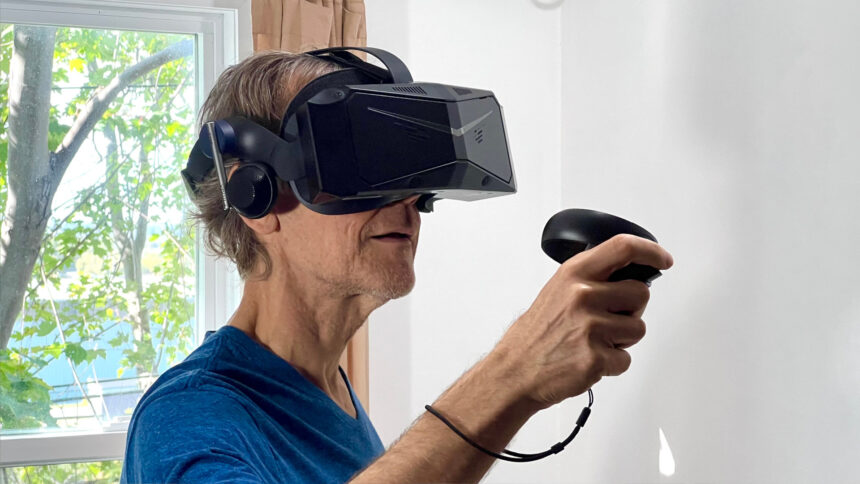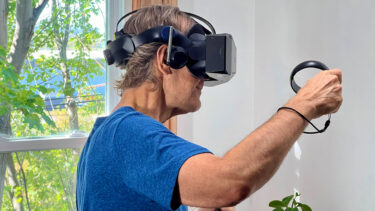Pimax Crystal’s standalone mode is in beta, and I tested the performance, graphics, and tracking of this new VR headset.
When the Pimax Crystal launched, some of its most unique features were missing, eye-tracking and standalone mode. Eye-tracking is arguably the most important since it unlocks foveated rendering and animated avatars. The Crystal’s foveated rendering reduces the burden on older GPUs when running PC VR games at higher resolutions.
Standalone mode lets you remove the tether and use the Pimax Crystal without a PC connection, similar to the Meta Quest 2, Quest 3 or the Pico 4. Pimax hasn’t done that before, so it’s interesting to explore how well it works on a high-end VR headset.
Enabling standalone mode
To use standalone mode on the Pimax Crystal, you need to update the Pimax Client Windows app to the latest version and update the headset and controller firmware. At the time of writing, standalone mode isn’t available unless you are a beta tester.

Once you’ve updated to firmware that supports standalone, you can power off the Crystal, unplug the DisplayPort cable from the headset, and switch the silver slide at the top right from PC to AIO (all-in-one). Power the headset on and you should see your controllers and be able to look around the Pimax standalone home environment.
The layout is similar to that of the Quest platform, but not identical. There’s a list of library apps, a store to browse standalone titles and settings to customize your experience. Pimax did a good job with the layout, and it was easy to navigate these features.
Performance and graphics
When using the Pimax Crystal as a standalone device, the processing power is greatly reduced. Even an older PC VR system is much faster than the Qualcomm Snapdragon XR2 chip in this device. It’s the same chip found in the Meta Quest 2, Pico 4 and many other budget priced VR headsets.
Of course, the Crystal is a high-end system, so you might expect something extra. The aspherical lenses are much better than the Meta Quest 2’s Fresnel lenses, so I didn’t have to worry about god rays obstructing my view. I haven’t tried the Pico 4 headset, which features pancake lenses, so I can’t make a comparison.

Graphics quality is good, but you shouldn’t expect top-quality graphics from the first-generation Snapdragon XR2. Although the Crystal has high-resolution displays, the XR2 can’t support that resolution while tracking the headset and controllers in a fast-paced game.
Overall, image quality is better than the Quest 2 but isn’t comparable to the incredible sharpness available when you connect the Pimax Crystal to a VR-ready PC. Pimax owners will primarily want to use PC VR, with standalone for games or apps that require more movement.
Standalone Tracking
I wasn’t surprised by the performance or graphics quality. The Snapdragon XR2 is a well-known chip that remains relevant despite its age. The Crystal’s lenses have good clarity with a large sweet spot, so nice picture quality makes sense.
I wasn’t so certain if Pimax could get inside-out headset and controller tracking right when running in standalone mode. Meta and Pico have had many years to optimize their software.
My concerns were needless. The Pimax Crystal’s tracking seems to work just as well as the Quest 2’s in the standalone games I tried. For the more rigorous and customized tracking required for simulators, the new Pimax Crystal-Sim bundles could be worth checking out.
Standalone games and apps
The only detail lacking in the Pimax Crystal standalone mode is its very limited library of titles. To be fair, this headset is meant for VR-sim fans, hardcore VR gamers, and VR enthusiasts that want the best PC VR experience available.
When standalone mode launches for everyone, Pimax says there will be 11 launch titles, including seven games, two fitness apps, a paint app and a media player.
OpenBrush is a popular, immersive painting app, and having the freedom to turn in circles without tying yourself up in a tether makes it one of the most compelling apps for standalone mode. X-Fitness is a rhythm-based workout app with great ratings in the Quest App Lab, another worthy entry.
For gaming, First Person Tennis is a well-rated sports simulator and David Slade Mysteries: Case Files is a nice graphic adventure game. That isn’t much to get excited about yet, but more games are in progress.
Now it’s up to developers to port games over to this new system, which will take time. How quickly that happens depends on how popular the Pimax Crystal is and how much interest there is in standalone mode.
Source: Mixed News






